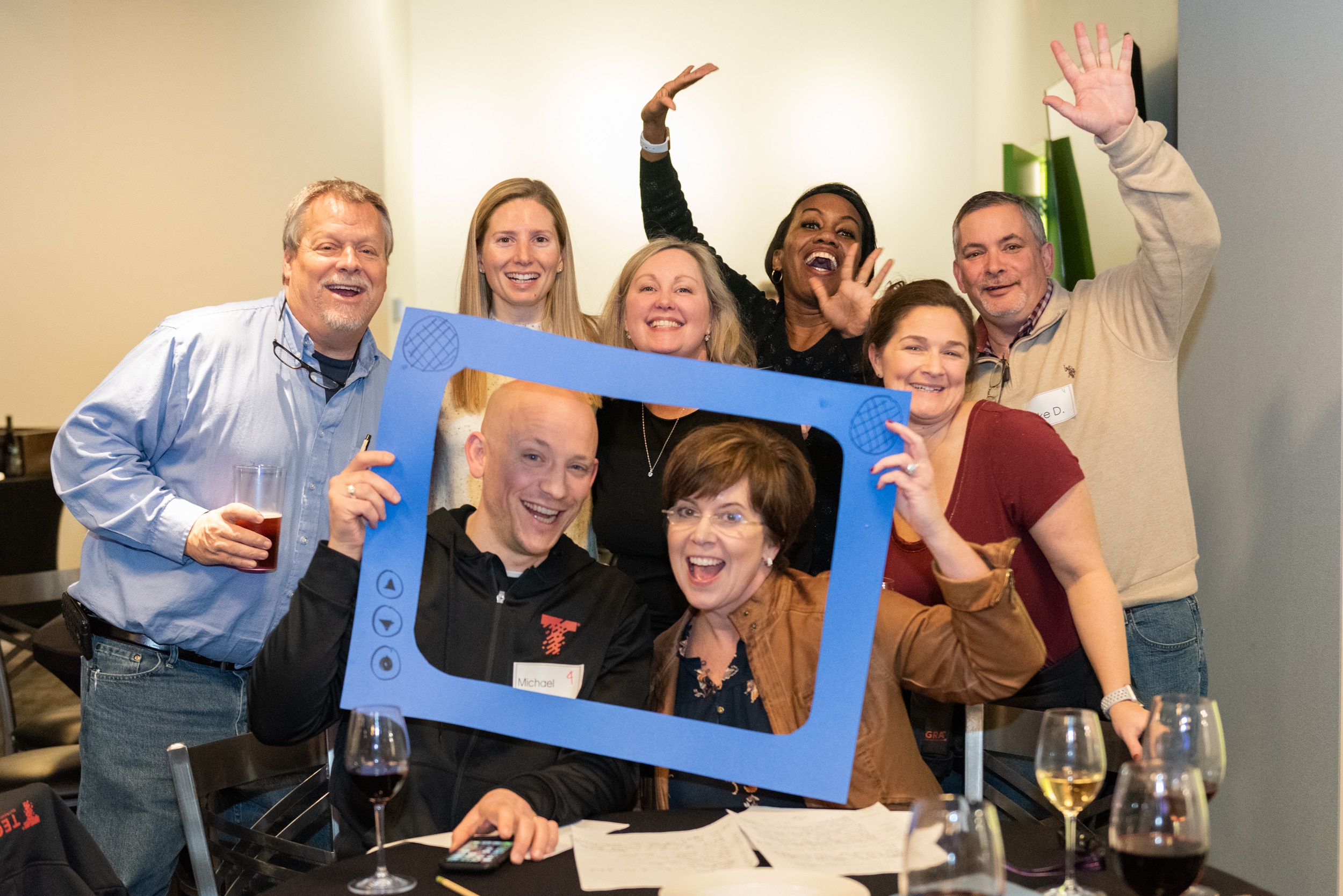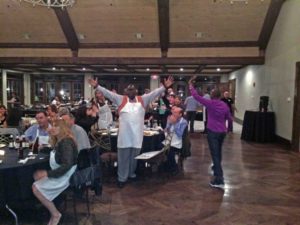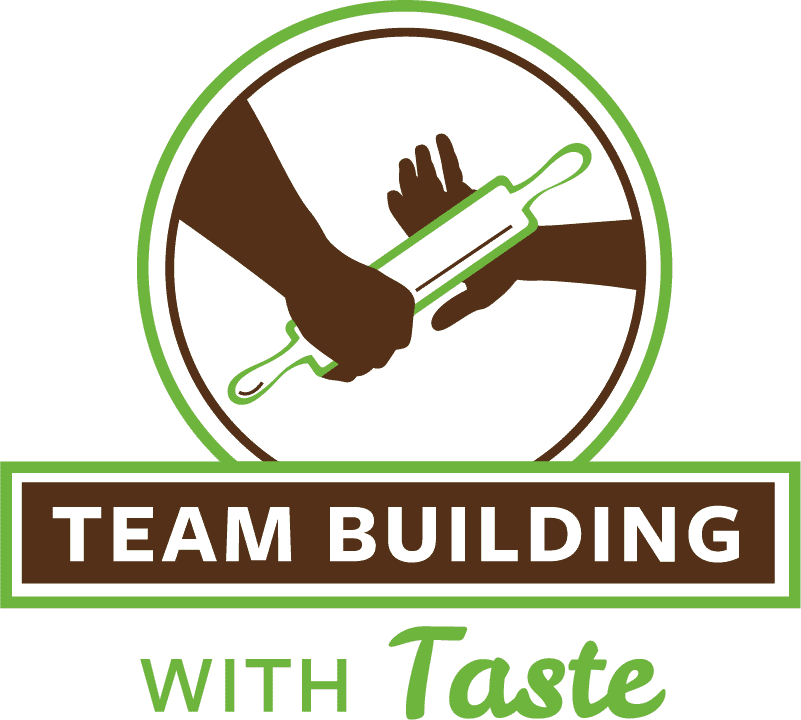Team Building Activities for Work: The Five Shades

At Team Building with Taste, we field all kinds of calls and requests for team building activities for work. We are constantly amazed by what the term “team building” means to different people. When we asked one group of young employees about the type of team building activities at work they had done, their answer was: “Well, HR came in and gave us a presentation.”
That may be the low end of team building, but it shows that the term can be interpreted many ways. Over the years, we’ve hosted and produced many types of team building events at our facility. Our event rooms have hosted serious, in-depth sessions conducted by team building consultants and leadership coaches. We’ve had lots of different creative “icebreakers” and kickoffs. Volleyballs with individual personality traits emblazoned on each panel have gone sailing around our kitchen. And yes, we’ve run quite a few Iron Chef team builders.
What is Team Building?
Team building is one of those things that’s hard to define, but you know it when you see it. So, it might be easier to start with the objective. In our opinion, all successful team building activities for work should have the primary goal of building trust among team members. Trust is the foundation of all teamwork. Its precursors are familiarity and respect. With the exception of sole practitioners or an individual contributor in a larger business, almost all important and lasting work is accomplished by teams.
If you don’t trust your co-workers, you won’t collaborate with them to the customer’s benefit. You also won’t share ideas or information; you won’t pitch in to help them when needed and you’ll care more about your situation than the team’s performance. Most importantly, your company or organization will have difficulty reaching its collective goals.
The Best Team Bonding Activities for Work Generate Trust
When it comes to trust, there are two types: competency and interpersonal. As his teammate, you must be confident that Rob can close the sale, write clean code or get the contract out on time. If you don’t trust him to be competent in his area of domain experience, you are less likely to work with him and help him. Just as important is personal trust. If you make a mistake, will Rob throw you under the bus? Is he a political animal, willing to talk behind your back? Does he try to make himself look good at the expense of others? If you don’t trust Rob as a person, you won’t trust him as a co-worker.
To trust someone, you first must know and respect them. Familiarity, respect and ultimately trust are the hallmarks of any team building effort. So how do you get there? From a practical standpoint, we see it as the five shades of team building. None are exclusive to each other. Many employee engagement managers strive to combine many of these into an annual program.
As someone who is interested in creating team bonding programs or purchasing outside team building activities for work, we hope you find the following high-level comparison helpful.
-
Connection Exercises
Often called “icebreakers,” these communication exercises usually involve a light structure to get people opening up and sharing something about themselves. The goal is to increase familiarity among team members and see each other in a new light. These can range from the simple, “Let’s go around the table and everybody mention something surprising about yourself,” to more elaborate exercises, such as “Have you ever…?” or “Two truths/one lie.”

-
Team Activities Outside of Work
Often confused with “team building,” and marketed as such, these activities are primarily designed to increase morale and keep everyone happy. Essentially, these are group outings, such as bowling or a night at the ballpark. Other examples include Top Golf, Escape Room, or just going out for wings and beer. Bringing people together outside of work is the goal. They add value in that they can be fun and usually some new connections are formed. They can move the needle a bit as far as familiarity and collegiality is concerned. But, since they are unstructured, they leave a lot to chance. For example, your experience depends on which table you are seated at or the lane you have at Top Golf.
-
Personality Assessments and Diagnostics
Often administered by HR professionals or outside consultants, these diagnostic tests are designed to illuminate individual personality traits and motivational drivers. The most common are the Herrmann Brain Dominance Instrument (HBDI), Myers-Briggs Type Indicator®, DiSC® and Gallup’s CliftonStrengths. When aggregated, these tests can also showcase organizational wide skills, traits and opportunities.
These team building activities for work are good management tools because they can show managers and others “what makes somebody tick,” and that information can be used to motivate them or deal with problems. When the results are shared among team members, which they frequently are, then it is enlightening for others to understand their teammates and it helps in working together and understanding each other. This contributes to respect and trust. The challenge is to map these assessments into organization goals and behavior change and to keep them from feeling too “touchy/feely.” For that reason, it is often best to look at these assessments as part of an ongoing process as well as an overlay onto other team building activities.
-
Goal-Oriented Team Building Activities
Team Building with Taste is plugged in here. In a limited time (usually an hour), participants have to develop a meal, plate it and present it to the group. The goal is to work together as a team with a time constraint and with some surprises along the way (secret ingredients/the guiding chef is pulled out of the room), to create a meal and sell it in order to win the contest.

Success and accomplishment at cooking
These goal-oriented activities foster familiarity and trust. The also generate a sense of accomplishment. You have to depend on each other to reach the goal. With a little deadline pressure (just like you have in real-life), the experience is enhanced and magnified. Another positive of these types of team building activities for work is that it takes people out of their comfort spaces and makes them work together in an unusual setting. Culinary team building or even virtual culinary team building is only one type of goal-oriented team building activity. Other good ones are bike building, raft building, pottery, improv classes and more.
-
Service Projects
Also known as altruistic team building, service projects can combine goal-oriented aspects with a “give-back” to a worthy organization. Habitat for Humanity is the gold standard for this type of activity. But even making pans of baked Ziti for a homeless shelter or building a library collection at a senior center are worthwhile. The activities tend incorporate the benefits of team building and combine them with a sense of purpose for the organization outside the normal money-making business operations. If you are looking for some ideas for service projects, here is a good list.
If you would like to speak with one of our representatives about virtual and in-person team building options, please contact us.

